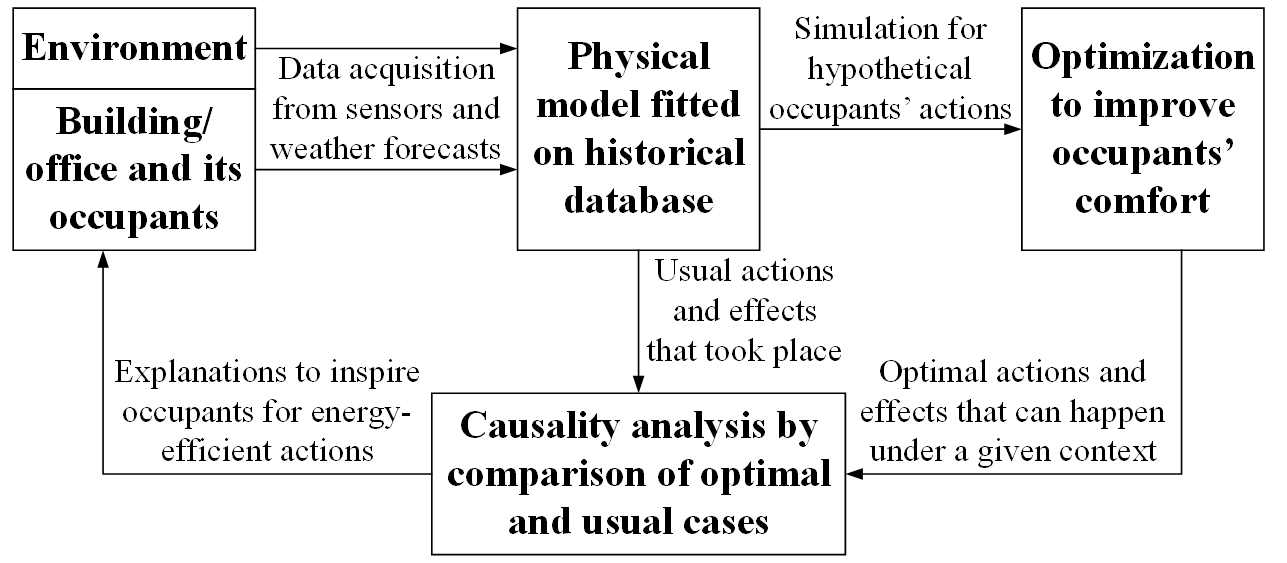Unmasking the causal relationships latent in the interplay between occupant's actions and indoor ambience: a building energy management outlook
Welcome to this webpage which presents the supplementary material for a case study on building energy management conducted in an office at Grenoble Institute of Technology, France. The objective of this work is to generate recommendations for a Pareto-optimal schedule of occupants' actions such that indoor thermal dissatisfaction, air quality dissatisfaction, energy-cost, and the number of actions recommended to a user could be minimized. As this forms an optimization problem with four objectives, a many-objective optimization algorithm is used to address this problem. Additionally, to motivate the occupants to adopt the recommendations, this work aims at generating explanations to describe which particular actions and how a particular action brings about the desired changes in the indoor ambience. Such an approach is even applicable to existing buildings and hence, it inspires building occupants to modify their behavior towards an energy-efficient future.
The following are the major contributions of the proposed work whose framework is illustrated below:
- presenting a case study to identify the optimal zonal human-based energy retrofits using a many-objective evolutionary algorithm in order to attain premium indoor thermal comfort and finest indoor air quality while minimizing energy consumption,
- providing a holistic occupant-building-environment interaction profile through hourly granularity of data acquisition and system-generated recommendations, and
- proposing the differential explanations approach which along with the analysis of influences assist in deciphering various causal impacts of occupant's actions.

Performance of the proposed approach
In order to provide a better comprehensibility of the proposed work, simulation results carried out on recordings of April 2015 to October 2016 are available at the supplementary material (downloadable from the link below) in the file named "Year_Round_Results.xlsx". In this regard, the following points are to be noted:
- As comfort is defined with respect to occupants, the proposed approach (simulation) is applied to those days when there is some occupancy in the office room. Otherwise, simulation is not carried out. Hence, there are no results for those days when the office remained closed.
- These results are noted using second generation approximation-guided evolutionary algorithm (AGE-II) which has been determined as a suitable algorithm for this application due to the reasons mentioned in the manuscript.
- Selection of the optimal action schedule from the set of Pareto-optimal solution is dictated by the automated decision-making strategy as reported in the manuscript.
Specifically, the spreadsheet has the following columns:
- Column 1 mentions the date of the day which provides the context.
- Columns 2 and 4 mention the recorded values of indoor room temperature (in K) and indoor CO2 concentration (in μmol per mol of air), respectively, both of which are averaged over 24 hours.
- Columns 3 and 5 mention the optimal values of indoor room temperature (in K) and indoor CO2 concentration (in μmol per mol of air) respectively, both of which are averaged over 24 hours.
- Columns 6 to 8 mention the quantified impact of optimal actions as follows:
- Average thermal dissatisfaction (unitless quantity) of a day in column 6
- Average CO2 based air quality dissatisfaction (unitless quantity) of a day in column 7
- Average of scaled expenses (indicator) for occupancy related energy consumption in column 8
- Column 9 mentions the fractional amount of work (caused by changes in recommended actions) to be performed in 24 hours, in order to achieve the optimal effects. It is also a unitless quantity.
- Column 10 mentions the French season with which the day is associated.
Click here to download the supplementary material.
Links to Other Projects

Visitor Counter

